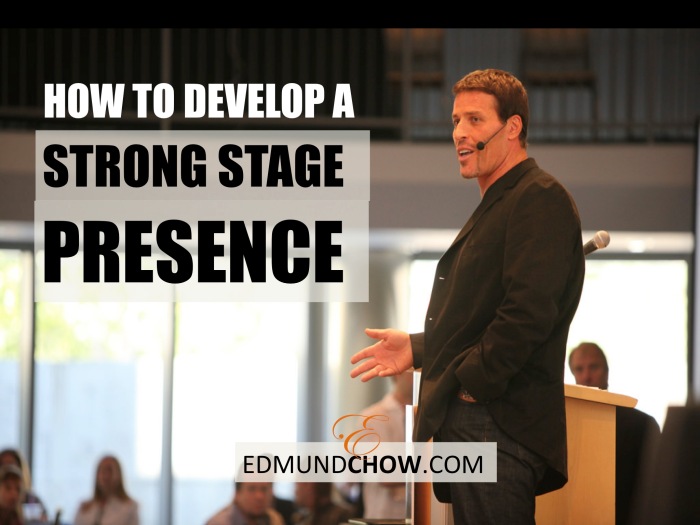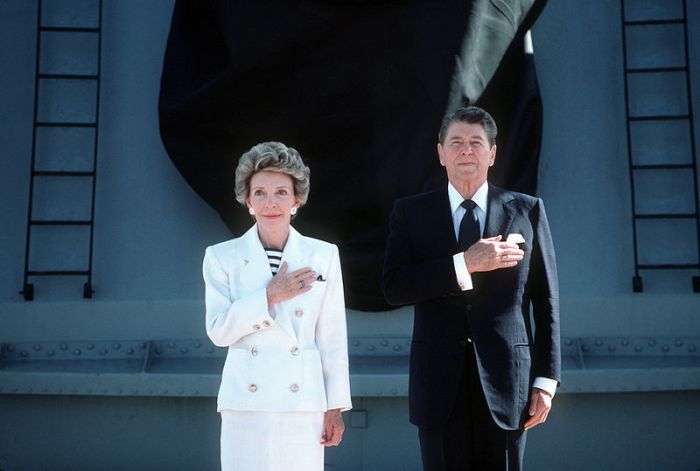
Stage presence is magnetism. It is charisma. It is a quality that cannot be defined. It is almost as intangible as clouds and incomprehensible as waves. It is an aura that emanates from within.
Some people can walk onto the stage with no pomp nor circumstance, but the audiences either go ballistic or are enthralled. Either way, there is a commanding presence – either of fear or awe.
Or both.
But physicality and stage presence are not necessarily causal. Being tall does not mean you will automatically command a strong stage presence. Looking tall does. It is about posture.
To a large extent, height helps. If you are as tall as Tony Robbins, who stands at 2 metres, there is a stronger likelihood that you will be ‘looked up to’. If you have broad shoulders and huge pectorals like him, there is a higher chance that he commands the space – both onstage and offstage. A towering figure always helps.
But physicality and stage presence are not necessarily causal. Being tall does not mean you will automatically command a strong stage presence. Looking tall does. It is about posture.
Here are my five basic suggestions:
1. WEIGHT PLACEMENT
The first and most obvious mistake many presenters make while giving a speech is giving more weight to one foot. In normal face-to-face conversations, it is typical to lean to one side of the body, with one leg straight and other leg, slightly bent at the knee. But this imbalance greatly reduces your personal power.

When you stand with an erect spine with weight equally distributed on both feet, you demand presence. The diagram above shows the difference. On the left, it is unbalanced, but on the right, it is well balanced.
A person with a strong presence has a strong, firm connection to the ground.
If you need to, remove your footwear. Shift your weight unevenly on your left foot, then your right. And then adjust until you stand on both feet with equal weight. Having a mirror here helps.
2. MOVE WITH PURPOSE
“It’s boring to stand still. That’s why I walk up and down,” says a client.
“But the problem with walking up and down is that your audiences don’t know where to focus. The left-right movement of the eyes in following you (while you walk) is highly distracting,” I replied. “This also makes speakers appear fidgety and unsure of themselves.”
You see, when you have no reason to move on stage, stay absolutely still from your waist level downwards, keeping in mind the equal weight balance from the first point above. This helps your audience to focus on you and your message.
But if you do feel the need to walk around in space, walk purposefully and with a very clear intention. Actors in a performance cannot walk anywhere on stage. These “routes” (what theatre directors call “blocking”) have been planned ahead of time and rehearsed until they look natural. But these movements have a purpose.
Maybe it is for you to walk to an audience member and pat him on the shoulder.
Maybe it is to walk to the projector and talk to a different side of the audience.
Maybe you are walking backwards to the whiteboard to write something.
Whatever it is, there is intention in the gait.
Sometimes, I tell speakers to walk when you need to deliver a new content point. Sometimes, you don’t need to walk, but simply shift your head in a different direction to add variety – but all these movements are intentional.
3. TALK SLOWLY
Speakers who speak very fast like a bullet train loses power. But when you speak slowly – and again with intention – you gain your audience. This means respecting the power of the pause.
When you speak slowly (but not throughout your entire presentation), you give your audiences the mental space to breathe and take in what you have to say. This allows you to connect with them at a high cognitive level. When you speak too quickly, it means you are nervous. And it also means you don’t really care about what you are saying, or if your audiences understood what you are trying to convey.
So, breathe… and slow down.
4. SPEAK DEEPLY
A lower pitched voice has a natural tendency to command. This is because a deep voice resonates from the chest – and the chest is closer to the heart. On the contrary, speaking with a high-pitched voice or with a shrill is connected to what singers call the “head voice”. It resonates in the head space.
Just imagine Mariah Carey singing her higher octave sounds for longer than 2 verses and you would probably shut off. It is more to demonstrate her vocal prowess and vocal range, but staying too high for too long makes you, unfortunately, shallow and powerless.
So learn to breathe deeply and speak in a lower-pitched voice.
It does not mean you start practising speaking in a pitch that is unnatural. It just means allowing your voice to boom and resonate from the chest – and when you do, you are emotionally connecting on a heart-to-heart level.
5. LOOK SOFTLY
When you have a small audience, it is important to give each of them a glance, a 1-second look to maintain rapport. With a small smile, your eyes naturally light up differently with a soft gaze. A stare is antagonistic, but a soft gaze connotes openness and transparency.
Sometimes it is necessary for you to look directly at one audience member for slightly more than one second. Maybe three seconds or four, like you are speaking directly to him or her. This is a very powerful technique to draw your audiences into your “space”, and hence, increase your charisma.
Try this to experiment the difference between a stare and a look.
Observe an object in the room. It could be a plush toy, or a TV screen. Or a photograph. Squint your eyes a little and pretend that you have a beam of light shooting out from your eyes. Think of yourself as a superhero trying to eliminate that object. Focus hard and concentrate without blinking. There is a mild squint in the eyes.
Now, relax.
Look at the same object with a relaxed eye muscle. Smile widely. Even wider. Now relax the smile and have a soft gaze on the same object. Convey lots of love and affection through your eyes. Pretend that it is your best friend, or your lover – and you want to hear what it wants to tell you. So your ears are open, your smile is turned upwards, and your gaze is on your object. You can blink naturally.
Hopefully, you can feel the difference. The latter is where you draw a strong connection with your audience. It is a love relationship.
In conclusion, developing a strong stage presence is not difficult. It is about your posture, attitude, and voice.
_____
Edmund Chow is a three-time award-winning public speaker. He is a drama educator, academic, and researcher. He uses drama to coach business executives and entrepreneurs in public speaking and storytelling.

















